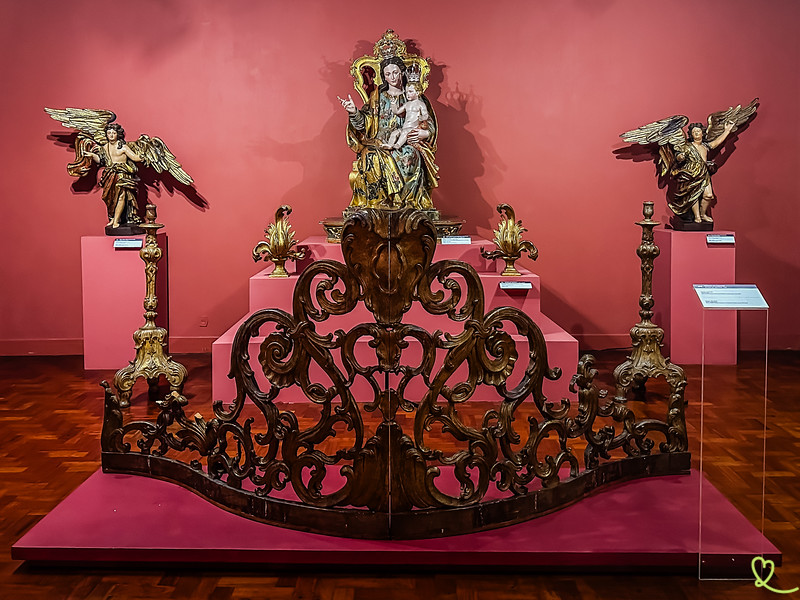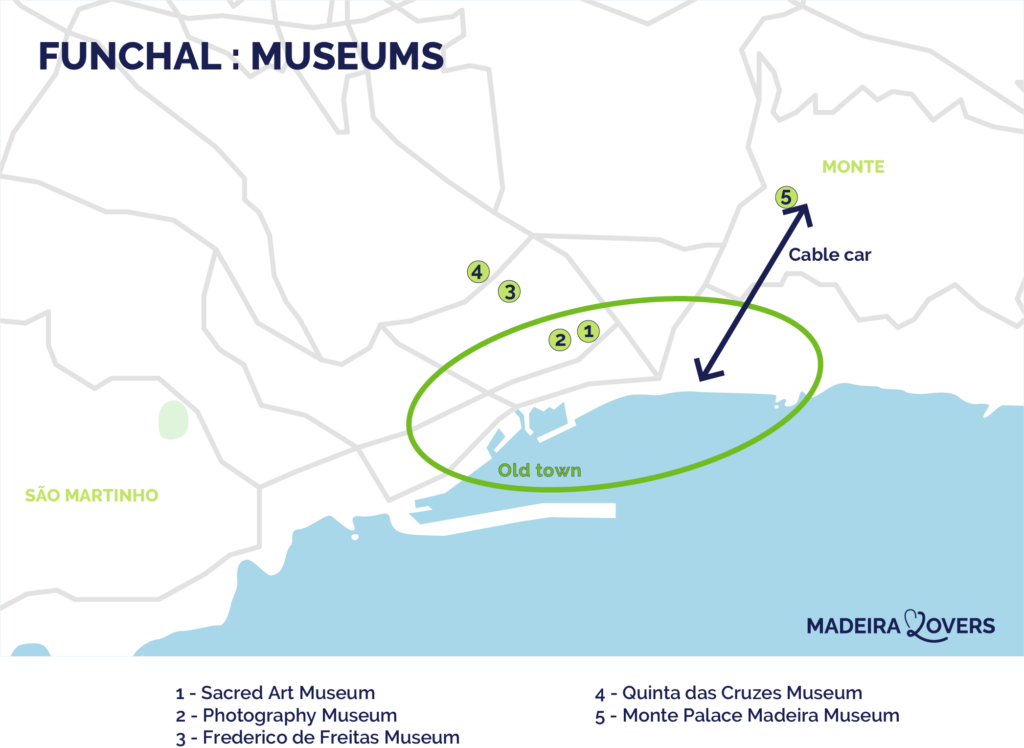We recommend a visit to Funchal’s Museum of Sacred Art. In addition to its rich collection of religious works, it boasts an outdoor terrace offering a breathtaking view of Madeira’s capital. We enjoyed this immersion in local culture through the prism of religion.
Check out our useful tips and photos to help you plan your visit and have a great time!

This opinion is completely independent, based on our experiences. We made our own choices, visited the area anonymously, and paid our bills in full.
Is a visit to Funchal’s Museum of Religious Art worthwhile?
In our opinion, the Museum of Sacred Art is definitely worth a visit during your stay in Funchal. In fact, it features in our article on the city’s best museums. Housed in the former episcopal palace on Piazza Largo do Colégioit houses a collection of works related to religion. Here we saw sacred paintings, sculptures and silverware that bear witness to the archipelago’s religious history.
>> Book your museum ticket now here <<

What you can see
The architecture of the bishop’s palace

Opened to the public in 1955, this museum is one of the best things to do in Funchal, thanks to its unique collection and typical architecture. Dating from the 18th century, the building housing the exhibition space is a former episcopal palace. We were astonished to discover that it was also Funchal’s high school between 1913 and 1942. As a result, it has served a variety of functions over the ages.
Processional crosses

The tour explores the importance of religion in local culture through a rich collection of sacred works. As we began our tour of the museum, we were intrigued by the many processional crosses on display, of varying shapes and sizes. The cross represents Christ’s redemptive death. It is also the main symbol of the Christian faith.
OUR TIPS FOR RENTING YOUR CAR AT Madeira
- Compare prices on our preferred platform: DiscoverCars – one of the best rated sites.
- Take a car with a good engine for hilly roads, but not too big for manoeuvring.
- There’s plenty of demand and few cars, so book early.

Chalices

Still in the same room, we recognized chalices that reflected the light with their golden hues. These receptacles are used during the Eucharist, or mass, to hold the bread and wine that symbolize the flesh and blood of Christ. We learned that these sacred vessels were generally made from noble metals.
Processional sticks

Continuing along the route, we discovered 2 processional sticks hanging on the wall. They caught our eye with their proud looks! Made by a local silversmith, they were commissioned to make up the treasure of the Sé Cathedral, replacing the old batons of King Manuel I.
Shuttles and incense burners

When we saw these sacred works, we didn’t immediately understand what they were all about. Our curiosity was really piqued! The shuttle is the container used to hold grains of incense during liturgical rites. Its name derives from its ship-like shape, more or less stylized and adopted from the 14th century onwards. This format was introduced in Europe and Portugal during the period of the great navigational explorations. Fascinating, isn’t it?
Gilded polychrome wood bas-reliefs

Entering a room with crimson walls, we were struck by the intensity of the contrast with the gold-colored works. Several gilded and polychrome wood bas-reliefs were on display. These were the remains of the repository used for the Holy Sacrament in Funchal Cathedral on Holy Thursday. They impressed us with their thousand and one sculpted details.
The many religious paintings and icons

On either side of the museum, you’ll discover numerous paintings linked to the world of religion. He mainly exhibited Flemish paintings in relatively dark tones. On the top floor, however, we were drawn to the predominantly gold icons depicting a profusion of sacred figures.
Sacred sculptures

Part of the Flemish art collection, the museum’s sculptures feature saints such as Nossa Senhora de Luz and São Sebastião. The latter particularly caught our eye, with its severed limbs and torso studded with holes.
The view from the azulejo terrace

To round off our visit in style, we headed for the museum’s outdoor terrace. Decorated with azulejos, it offers a breathtaking view of the city’s orange roofs. The ocean loomed on the horizon. It echoed the bluish hues of the decorated tiles. For the tall among you, the door is relatively low. Be careful not to bump into it!
WHERE TO STAY IN Madeira
Our independent picks for the accommodation of your dreams:

The Museum of Sacred Arts in Funchal: how to get there
Where is the museum?
- On the island of Madeira,
- In the capital Funchal,
- In the old town,
- On the Square Largo do Colégio,
- BetweenSaint-Jean-l’Évangéliste Church and Sé,
- The entrance is on Rua do Bispo.
Our map of Madeira’s best museums will help you find your way around the city:

Access by car and parking
We do not recommend driving in the old town. The narrow, cobbled streets are popular with tourists. Some are even completely pedestrianized. Choose a parking lot outside the historic center, such as Parking Santa Luzia. It is open from 6am to 10pm on weekdays. Then simply walk down Rua 5 de Outubro to reach Old Funchal. The museum is just a 5-minute walk from this parking lot.

Public transport access
Several bus stops are located in Rua 5 de Outubro, close to the museum, including lines 12, 17, 20 and 21. Find out more here.
Access on organized tours
For the more curious among you, opt for a guided tour of Funchal, including a visit to the Museum of Sacred Art and the Frederico de Freitas Museum, which we really enjoyed! This historical tour also includes a tasting of local specialties and Madeira’s famous wine.

Visiting difficulties
The museum is partially accessible to people with reduced mobility. The first floor has a ramp to the ticket office, but no elevator. Portable folding chairs are available for visitors. To reach the upper floors, you have to climb a steep staircase.

OUR FAVORITE ACTIVITY IN Madeira
Catamaran tour to see dolphins and Madeira’s giant cliffs.

Visiting Madeira’s Museum of Sacred Art: useful tips
Schedules and prices
The museum is open from 10am to 5:30pm Monday to Friday, and from 10am to 1:30pm on Saturdays. Closed on Sundays. Check out the latest news on the official website here.
Admission costs €10, and is free for children under 12.
For how long?
Allow 30min to 1h to visit the museum and contemplate its magnificent view.
Best moment
Preferably outside the summer season (July, August) and school vacations. This way, you can avoid busy periods, although tourists generally prefer outdoor activities in Madeira. Choose morning slots as soon as they open, or during lunchtime. Attendance is generally lower in these slots. What a pleasure to discover the terrace alone! We enjoyed the view in peace and quiet.

Direction of visit
There is no set direction, but the route is signposted. You start on the first floor, where the ticket office is located. You’ll then progress from one floor to the next, wandering room by room, before finishing on the outdoor terrace at the top of the museum. We followed the directions as we went along, without asking too many questions. We noticed QR codes on the walls, linking to a detailed fact sheet in French, which can be used as a support during the visit.

Visiting with children
We didn’t notice any special tours for children, or any fun games. The subject of the museum itself is unlikely to appeal to younger visitors.
Eating out
The museum has the Restaurant Museu Café & Petisco directly on site.
For more inspiration, discover our selection of the best restaurants in Funchal!

Hotels
You’re right in the heart of Funchal’s old town. Discover our complete article on the best hotels in the historic center. If not, find our 2 favorite establishments below:
- Three House apartment hotel (4 stars) – See prices, photos and availability.
- Castanheiro Boutique-Hotel (4 stars) – See prices, photos and availability.

PLAN YOUR STAY IN Madeira
Best of
Things to do in Madeira
Most beautiful viewpoints
Madeira’s most beautiful beaches
Most beautiful gardens
Natural pools
Most beautiful hikes
Most beautiful roads
Secret places

Practical advice
Getting around Madeira
Rent a car in Madeira
Driving in Madeira
Itineraries: 3 days – 4 days – 5 days – 6 days – 7 days – 10 days




